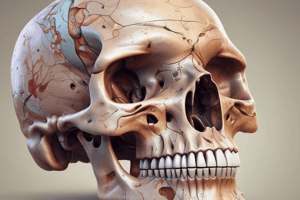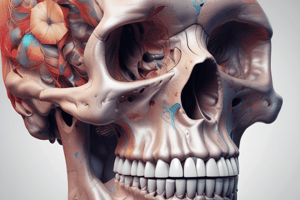Podcast
Questions and Answers
What type of joint is the Temporomandibular Joint (TMJ)?
What type of joint is the Temporomandibular Joint (TMJ)?
- Synovial joint (correct)
- Skeletal joint
- Cartilaginous joint
- Fibrous joint
The Mandibular Symphysis is defined as what type of joint?
The Mandibular Symphysis is defined as what type of joint?
- Fibrous joint
- Synovial joint
- Secondary cartilaginous joint (correct)
- Primary cartilaginous joint
Which of the following structures does NOT directly relate to the hyoid apparatus?
Which of the following structures does NOT directly relate to the hyoid apparatus?
- Larynx
- Tongue
- Thyroid cartilage
- Mandible (correct)
What general function does the hyoid apparatus serve?
What general function does the hyoid apparatus serve?
Which of the following best describes the relationship between the hyoid apparatus and the Temporomandibular Joint?
Which of the following best describes the relationship between the hyoid apparatus and the Temporomandibular Joint?
What anatomical feature is referred to as the nasoincisive notch in a horse skull?
What anatomical feature is referred to as the nasoincisive notch in a horse skull?
Which bone is not typically found in the horse skull?
Which bone is not typically found in the horse skull?
The hyoid apparatus in horses functions primarily in which of the following?
The hyoid apparatus in horses functions primarily in which of the following?
What is the significance of the facial crest in horse anatomy?
What is the significance of the facial crest in horse anatomy?
How does the horse skull compare to the skulls of other animals such as bovine and porcine?
How does the horse skull compare to the skulls of other animals such as bovine and porcine?
Which of the following structures can be observed in both equine and bovine skulls?
Which of the following structures can be observed in both equine and bovine skulls?
What role does the frontal bone play in the horse skull?
What role does the frontal bone play in the horse skull?
In terms of anatomy, the term 'conformation' primarily refers to what aspect of an animal?
In terms of anatomy, the term 'conformation' primarily refers to what aspect of an animal?
What type of skull is characterized by a short and broad shape, commonly found in certain dog breeds?
What type of skull is characterized by a short and broad shape, commonly found in certain dog breeds?
Which view of the skull allows for the examination of the nasal structures and the upper jaw?
Which view of the skull allows for the examination of the nasal structures and the upper jaw?
Which type of skull shape is typically more elongated, commonly found in breeds like Greyhounds?
Which type of skull shape is typically more elongated, commonly found in breeds like Greyhounds?
What is the primary purpose of examining a skull from a dorsal view?
What is the primary purpose of examining a skull from a dorsal view?
In a brachycephalic skull, which features are often observed?
In a brachycephalic skull, which features are often observed?
Which animal skulls are primarily examined for understanding brachycephalic traits?
Which animal skulls are primarily examined for understanding brachycephalic traits?
What critical feature distinguishes the horse skull from brachycephalic skulls?
What critical feature distinguishes the horse skull from brachycephalic skulls?
Which of the following is NOT a characteristic of a brachycephalic skull?
Which of the following is NOT a characteristic of a brachycephalic skull?
Which foramen is associated with the mandibular branch of the trigeminal nerve, CNV3?
Which foramen is associated with the mandibular branch of the trigeminal nerve, CNV3?
What structure passes through the oval foramen?
What structure passes through the oval foramen?
Identify the foramen related to the trigeminal nerve that is not directly associated with the mandibular branch.
Identify the foramen related to the trigeminal nerve that is not directly associated with the mandibular branch.
Which of the following foramina is NOT mentioned as being associated with CNV3?
Which of the following foramina is NOT mentioned as being associated with CNV3?
What is the primary role of the mandibular branch of the trigeminal nerve?
What is the primary role of the mandibular branch of the trigeminal nerve?
Which foramen is specifically responsible for the exit of the trigeminal nerve's mandibular branch from the skull?
Which foramen is specifically responsible for the exit of the trigeminal nerve's mandibular branch from the skull?
The mental foramen is primarily associated with what type of function?
The mental foramen is primarily associated with what type of function?
Which of the following structures is incorrectly paired with its respective function?
Which of the following structures is incorrectly paired with its respective function?
What can invade the tooth root?
What can invade the tooth root?
Which nerve is blocked for local anaesthesia during dehorning?
Which nerve is blocked for local anaesthesia during dehorning?
What is a primary consideration when performing dehorning?
What is a primary consideration when performing dehorning?
Which statement about horns is true?
Which statement about horns is true?
What is the shape of goat horns compared to sheep horns?
What is the shape of goat horns compared to sheep horns?
What complication can occur if horns grow into the head?
What complication can occur if horns grow into the head?
Which of the following is NOT required during the disbudding process?
Which of the following is NOT required during the disbudding process?
What can escalate the risks associated with dehorning cattle?
What can escalate the risks associated with dehorning cattle?
What determines the shape of a sheep's/horn's cross section?
What determines the shape of a sheep's/horn's cross section?
What is a potential risk of disbudding using hot irons?
What is a potential risk of disbudding using hot irons?
Which statement about sinuses is true?
Which statement about sinuses is true?
What is a common method for disbudding calves?
What is a common method for disbudding calves?
What must be assessed before dehorning procedures?
What must be assessed before dehorning procedures?
Flashcards
Brachycephalic Skull
Brachycephalic Skull
A skull shape characterized by short and broad dimensions, affecting dental and respiratory health.
Horse Skull Features
Horse Skull Features
Horse skulls have distinctive features like the nasoincisive notch and prominent facial crest.
Hyoid Apparatus
Hyoid Apparatus
A structure that supports the base of the tongue and aids in swallowing, relevant in bovine and porcine anatomy.
Temporomandibular Joint (TMJ)
Temporomandibular Joint (TMJ)
Signup and view all the flashcards
Mandibular Symphysis
Mandibular Symphysis
Signup and view all the flashcards
Apical Abscesses
Apical Abscesses
Signup and view all the flashcards
Maxillary Sinus Infections
Maxillary Sinus Infections
Signup and view all the flashcards
Permanent Horns in Cattle
Permanent Horns in Cattle
Signup and view all the flashcards
Frontal Sinus Influence on Horns
Frontal Sinus Influence on Horns
Signup and view all the flashcards
Cornual Nerve Innervation
Cornual Nerve Innervation
Signup and view all the flashcards
Veterinary Dehorning
Veterinary Dehorning
Signup and view all the flashcards
Disbudding vs. Dehorning
Disbudding vs. Dehorning
Signup and view all the flashcards
Local Anesthesia for Horn Procedures
Local Anesthesia for Horn Procedures
Signup and view all the flashcards
Placement of Local Anesthetic
Placement of Local Anesthetic
Signup and view all the flashcards
Larger Horn Anesthesia
Larger Horn Anesthesia
Signup and view all the flashcards
Unique Horn Shapes by Species
Unique Horn Shapes by Species
Signup and view all the flashcards
Complications from Improper Horn Growth
Complications from Improper Horn Growth
Signup and view all the flashcards
Foramina and Cranial Nerves
Foramina and Cranial Nerves
Signup and view all the flashcards
Mandibular Foramen Significance
Mandibular Foramen Significance
Signup and view all the flashcards
Mental Foramen Role
Mental Foramen Role
Signup and view all the flashcards
Anatomy for Surgical Interventions
Anatomy for Surgical Interventions
Signup and view all the flashcards
Throat Issues Diagnosis
Throat Issues Diagnosis
Signup and view all the flashcards
Aiding in Swallowing
Aiding in Swallowing
Signup and view all the flashcards
Veterinary Studies Importance
Veterinary Studies Importance
Signup and view all the flashcards
Sinus and Dental Connections
Sinus and Dental Connections
Signup and view all the flashcards
Surgical Procedure Risks
Surgical Procedure Risks
Signup and view all the flashcards
Horn Development Timing
Horn Development Timing
Signup and view all the flashcards
Cattle Horn Structure
Cattle Horn Structure
Signup and view all the flashcards
Cornual Nerve Summary
Cornual Nerve Summary
Signup and view all the flashcards
Pressure Necrosis Effects
Pressure Necrosis Effects
Signup and view all the flashcards
Study Notes
Brachycephalic Skull and Horse Skull
- Brachycephalic skulls are characterized by short and broad shapes, affecting dental and respiratory health.
- Horse skulls have distinctive features including a nasoincisive notch and prominent facial crest.
- Essential for understanding anatomical variations in veterinary studies.
Hyoid Apparatus
- The hyoid apparatus supports the base of the tongue and aids in swallowing.
- Important in both bovine and porcine anatomy.
- Useful for diagnosing issues related to the throat and feeding in animals.
Temporomandibular Joint (TMJ)
- The TMJ connects the jawbone to the skull, crucial for movement.
- Mandibular symphysis is a cartilaginous joint allowing slight movement between mandibles.
- Apical abscesses in teeth may lead to sinus infections, indicative of systemic health issues.
Sinus Infection and Horns in Cattle
- Maxillary sinus infections can develop from dental issues, underscoring the connection between oral and sinus health.
- Cattle possess permanent horns, formed from bone and continuously growing, unlike seasonal antlers.
- Horn development is influenced by the frontal sinus, beginning at around six months of age.
Horn Innervation and Surgical Procedures
- Innervation of horns is via the cornual nerve, a branch of the trigeminal nerve (CNV2).
- Dehorning must be performed by a veterinary surgeon due to risks of bleeding and infection.
- Disbudding is easier than removal and typically involves local anesthetic to minimize pain during the procedure.
Local Anesthesia Techniques
- Local anesthesia can block the cornual nerve effectively to manage pain during horn-related procedures.
- Anesthesia involves careful placement of the local anesthetic between the eye's lateral canthus and the horn base.
- Larger horns may require additional infiltration of anesthetic for comprehensive desensitization.
Considerations for Horn Anatomy
- Different species exhibit unique horn shapes: goats have oval, straight horns; sheep have triangular, curled horns.
- Complications can occur with improper horn growth, such as pressure necrosis affecting the skull.
- Understanding horn anatomy is crucial for veterinary surgical interventions.
Foramina and Cranial Nerves
- Key foramina relevant to the cranial nerves include the oval foramen and mandibular foramen for the mandibular branch of the trigeminal nerve (CNV3).
- The mental foramen also plays a role in the anatomy related to sensory innervation of the jaw.
- Knowledge of these structures is essential for surgical procedures involving dental and oral interventions.
Studying That Suits You
Use AI to generate personalized quizzes and flashcards to suit your learning preferences.
Description
Explore essential concepts in veterinary anatomy by examining the characteristics of brachycephalic and horse skulls, along with the hyoid apparatus. This quiz delves into the anatomical features crucial for diagnosing health issues in animals, including the temporomandibular joint and sinus infections. A must for students of veterinary studies.




